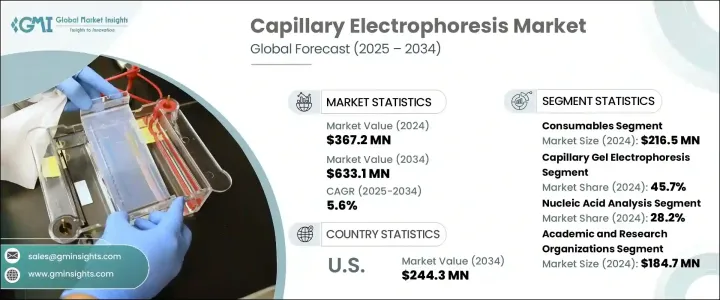
세계의 모세관 전기 영동 시장은 2024년 3억 6,720만 달러로 평가되었고, 2034년에는 6억 3,310만 달러에 달할 것으로 예측되며, CAGR 5.6%로 성장할 전망입니다. 의료 산업이 보다 정확하고 개인화된 데이터 기반 치료 접근 방식으로 전환함에 따라 모세관 전기 영동과 같은 효율적인 분석 도구에 대한 수요가 증가하고 있습니다. 이 기술은 크기와 전하에 따라 작은 분자나 이온을 분리하는 정밀도가 높아 유전자 분석, 질병 진단, 제약 연구에 매우 효과적이기 때문에 각광받고 있습니다. 유전체학, 단백질체학, 법의학 분야에서 활용도가 높아지면서 모세관 전기 영동은 학계, 임상 및 산업 연구 환경에서 계속 주목을 받고 있습니다.

연구자와 임상의들은 유전자 변이를 탐지하고 병원균을 모니터링하며 복잡한 생물학적 혼합물을 분석하기 위해 이 방법에 점점 더 의존하고 있으며, 이는 더 나은 표적 치료법을 수립하고 전반적인 환자 치료 결과를 개선하는 데 도움이 되고 있습니다. 또한 R&D에 대한 투자 증가, 첨단 진단 방법에 대한 규제 지원, 차세대 시퀀싱 워크플로우에 대한 이 기술의 빠른 통합으로 인해 시장은 강력한 모멘텀을 목격하고 있습니다. 정밀 의학에 대한 전 세계적인 수요가 증가함에 따라 모세관 전기 영동은 분자 진단 툴킷의 필수적인 부분으로 부상하고 있습니다.
| 시장 범위 | |
|---|---|
| 시작 연도 | 2024년 |
| 예측 연도 | 2025-2034년 |
| 시작 금액 | 3억 6,720만 달러 |
| 예측 금액 | 6억 3,310만 달러 |
| CAGR | 5.6% |
시장은 기기, 소모품, 소프트웨어로 세분화됩니다. 이 중 소모품은 2024년 2억 1,650만 달러로 가장 큰 비중을 차지했으며, 2034년까지 5.4%의 CAGR로 성장할 것으로 예상됩니다. 모세혈관 및 특수 시약과 같은 소모품은 기술의 무결성과 성능을 유지하는 데 매우 중요합니다. 실험실에서 정확한 결과를 보장하기 위해 일관된 고품질 소모품에 크게 의존하고 있기 때문에 이 부문은 일상적인 수요에 힘입어 꾸준한 성장을 이어가고 있습니다.
유형별로 모세관 겔 전기 영동(CGE) 부문은 2024년 45.7%의 시장 점유율을 차지했습니다. CGE는 DNA, RNA, 단백질과 같은 대형 생체 분자를 분리하는 데 널리 사용되며 유전자 염기서열 분석, 돌연변이 분석, 프로테오믹스에 널리 사용되는 기술입니다. 매우 정확한 결과를 제공하는 능력 덕분에 복잡한 생물학적 화합물을 분리해야 하는 연구 및 진단 애플리케이션에 없어서는 안 될 필수 요소입니다.
미국의 모세관 전기 영동 시장은 특히 종양학 분야에서 질병 조기 발견에 대한 수요 증가에 힘입어 빠르게 확대되고 있습니다. 이 기술은 암과 관련된 유전자 마커의 고해상도 분석을 가능하게 하여 개인 맞춤형 치료 계획의 개발을 용이하게 합니다. 선도적인 연구 기관의 지속적인 혁신으로 특히 바이오마커 식별 분야에서 기술의 정밀도가 향상되고 있습니다.
Thermo Fisher Scientific, QIAGEN, Bio-Techne 및 Agilent Technologies와 같은 주요 기업들은 제품 포트폴리오를 발전시키는 데 주력하고 있습니다. 이러한 기업들은 기기의 감도를 높이고 소모품 성능을 개선하며 개인 맞춤형 의료 솔루션에 대한 수요 증가에 발맞춰 통합 시스템을 도입하기 위한 협업을 추구하고 있습니다.
The Global Capillary Electrophoresis Market was valued at USD 367.2 million in 2024 and is estimated to grow at a CAGR of 5.6% to reach USD 633.1 million by 2034. As the healthcare industry shifts toward more accurate, personalized, and data-driven treatment approaches, the demand for efficient analytical tools like capillary electrophoresis is on the rise. This technology is gaining ground due to its high precision in separating small molecules or ions based on size and charge, which makes it exceptionally effective for genetic analysis, disease diagnostics, and pharmaceutical research. With growing applications in genomics, proteomics, and forensic science, capillary electrophoresis continues to attract attention across academic, clinical, and industrial research landscapes.

Researchers and clinicians are increasingly leaning on this method to detect genetic mutations, monitor pathogens, and analyze complex biological mixtures, which is helping them formulate better-targeted therapies and improve overall patient outcomes. The market is also witnessing strong momentum due to rising investments in R&D, regulatory support for advanced diagnostic methods, and the rapid integration of this technology into next-generation sequencing workflows. As global demand for precision medicine grows, capillary electrophoresis is emerging as an indispensable part of the molecular diagnostics toolkit.
| Market Scope | |
|---|---|
| Start Year | 2024 |
| Forecast Year | 2025-2034 |
| Start Value | $367.2 Million |
| Forecast Value | $633.1 Million |
| CAGR | 5.6% |
The market is segmented into instruments, consumables, and software. Among these, consumables held a significant share, generating USD 216.5 million in 2024, and are expected to expand at a CAGR of 5.4% through 2034. Consumables such as capillaries and specialized reagents are critical to maintaining the integrity and performance of the technique. With laboratories relying heavily on consistent, high-quality consumables to ensure accurate results, this segment continues to see steady growth driven by routine demand.
Based on type, the capillary gel electrophoresis (CGE) segment accounted for a 45.7% market share in 2024. CGE is widely used to separate large biomolecules like DNA, RNA, and proteins, making it a go-to technique for genetic sequencing, mutation analysis, and proteomics. Its ability to deliver highly accurate results makes it indispensable for research and diagnostic applications that require the separation of complex biological compounds.
The U.S. Capillary Electrophoresis Market is expanding rapidly, driven by rising demand for early disease detection, especially in oncology. The technique enables high-resolution analysis of genetic markers linked to cancer, facilitating the development of personalized treatment plans. Ongoing innovations from leading research institutions are enhancing the technique's precision, particularly in biomarker identification.
Leading players, including Thermo Fisher Scientific, QIAGEN, Bio-Techne, and Agilent Technologies, are focused on advancing their product portfolios. These companies are enhancing instrument sensitivity, improving consumable performance, and pursuing collaborations to introduce integrated systems that align with the growing need for personalized healthcare solutions.